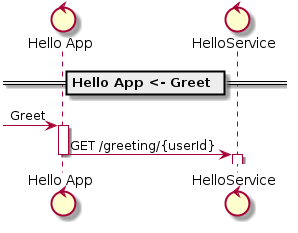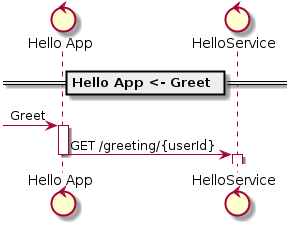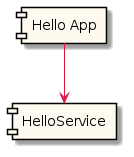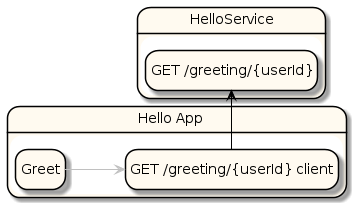Tutorial
In this tutorial, we're going to create a simple Sysl specification (i.e. a .sysl file), and use the sysl command line tool to generate a variety of outputs. We will touch briefly of many of features of Sysl, and link to in-depth guides where you can learn more.
Hello World#
Sysl specifications appear similar to YAML, with nested blocks of text organised with colons and indentation. However Sysl specifications are not just raw data: each block models a particular concept determined by its level and type.
Let's start with a simple example: modelling a greeting system that will authenticate the user to get their name, and then display a personalised greeting. By the end we'll be generating diagrams like this:

Applications#
Create a new file called hello.sysl with the following content:
HelloService: ...This is an empty model of an application called HelloService. An application is a component of a system, for example a web service, mobile app, or database.
The first line here consists of an application name followed by a colon to start an indented block, which will specify the named application.
The ... on the second line is a placeholder. You can use placeholders when you don't yet have some details of the specification. Sysl specifications are living documents that evolve alongside the systems as they're designed and built.
This is already a valid Sysl specification. We can't generate anything interesting from it, but we can see that sysl is able to parse it and output the information as a protobuf for other tools to use:
sysl protobuf --mode=json hello.sysl{ "apps": { "HelloService": { "name": { "part": [ "HelloService" ] }, "endpoints": { "...": { "name": "..." } }, [...]}See Exporting Sysl for more about outputting Sysl protobufs.
Endpoints#
HelloService is a web service that returns the user's greeting. In Sysl, applications are modelled as a collection of endpoints, so we'll add a new greeting endpoint below HelloService::
# The fantastic Hello World greeting system.
HelloService: /greeting/{userId <: int}: GET: ...A few things are happening here:
# begins a comment. The first line is just describing the system represented by the specification (this is of course optional).
/greeting/{userId <: int} is the path of the endpoint. Using a path indicates that this endpoint is a REST endpoint; RPC endpoints can also be specified with a function signature (e.g. GetGreeting(userId <: int)).
{userId <: int} describes a path parameter of type integer. Whatever value is provided when calling the endpoint will be interpreted as an integer, and bound to the name userId.
info
The <: is the "set element" operator. x <: Y asserts that x is in the set Y. Sysl uses it for specifying the type of a variable. In this case, it reads as "userId is an integer" (i.e. "userId is in the set of all integers")".
The GET in the block beneath the path indicates the HTTP method of the endpoint. This is the end of the endpoint declaration. In sum, we've specified that "HelloService exposes a REST endpoint GET /greeting/{userId <: int}".
The block following the endpoint declaration models its behaviour. We've once again used the placeholder ... to indicate that we don't have a detailed specification for it yet.
So far all we've specified is names, so we still can't generate anything of much use. But we're making progress! In the meantime, we can validate that the specification is still valid:
sysl validate hello.syslvalidate displays no output if the input is valid.
Communication#
Let's introduce another application so that we can model some communication. The user is going to receive their greeting via a mobile app called Hello App (yes, spaces are okay), which will fetch the greeting to display from HelloService.
As mentioned above, Sysl generally models components as "applications with endpoints". A natural interpretation for user-facing applications is that the app is an application, and each screen (or task) within the app is an endpoint.
You can probably guess what happens next:
# The fantastic Hello World greeting system.
HelloService: /greeting/{userId <: int}: GET: ...
Hello App: Greet: HelloService <- GET /greeting/{userId}We've added a new Hello App application with a Greet endpoint, and specified its behaviour. The behaviour says that Greet does one thing: it sends a request to HelloService, invoking the GET /greeting/{userId} endpoint (the app <- endpoint operator can be read like "app receives call to endpoint").
Note that the <: int parameter type specification is present in the endpoint definition, but not the call.
note
At this level of detail, we're not interested in specifically what happens to the result of the call. However Sysl has a special grammar for specifying more detailed behaviour as transformations.
Now that our system has some communication happening, we can generate some useful output. Diagrams are the most common representation of Sysl specifications, since they are visual, rich, standard, and easily shared.
Let's create a sequence diagram illustrating the communication. Sequence diagram generation requires an interaction (i.e. an endpoint invocation) to draw, so we'll use Hello App <- Greet
sysl sd --endpoint="Hello App <- Greet" hello.syslThis produces the diagram below:

This shows Hello App sending a GET /greeting/{userId} request to HelloService. Great!
However it's a bit clunky to have to spell out the full endpoint name for every diagram that we want to generate. Sure, you could write a script with multiple calls, but that would grow stale as the spec evolves. To keep it all in the Sysl universe, we have the concept of a project.
Projects#
Sysl is designed to be used by project teams within the context of a larger organisation. These teams must generate certain documentation relating to a subset of the applications in the system.
Sysl has a concept of a project that represents a view, a particular subset of a Sysl model for which to generate outputs.
Let's demonstrate by creating a project that captures the whole system:
# The fantastic Hello World greeting system.
HelloService: /greeting/{userId <: int}: GET: ...
Hello App: Greet: HelloService <- GET /greeting/{userId}
HelloProject: Greeting: Hello App HelloService Hello App <- GreetNotice that the structure is similar to that of an application: three nested blocks. Indeed, generating a diagram of the whole module will treat HelloProject as an application, because there's nothing special about it.
However when invoking sysl to generate diagrams, we can provide HelloProject as the project parameter. Then the inner-most block is interpreted as a list of applications and endpoints of interest. The resulting diagram will contain only those (and not a box for HelloProject).
Let's take a look:
sysl sd --app HelloProject hello.sysl
sysl ints --project HelloProject hello.sysl
sysl ints --epa --project HelloProject hello.sysl
Now we're getting somewhere! These diagrams are pretty basic, but they will grow with the Sysl model. You can also customise them with additional model attributes and command line flags. See Diagram Generation for more details.
Next steps#
This is just scratching the surface of what Sysl can do, but hopefully you're starting to see how it can be used to support and maintain the design, implementation and testing of an application, and of the whole enterprise.